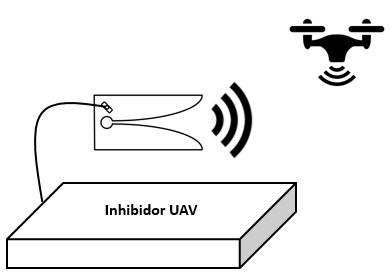UAV Jammer Prototype Implementation and Design
DOI:
https://doi.org/10.18667/cienciaypoderaereo.663Keywords:
Air defense, drone, electronic warfare, UAV jamming, mitigation, neutralizationAbstract
Unmanned aerial vehicles (uavs) easy access and proliferation have caused many incidents around the world over the last years. Numerous governments have joined forces to control and regulate the operation of these devices, promoting the creation of solutions to allow detection and mitigation of potential attacks from these platforms. Therefore, this paper presents the implementation and design process of an uav jamming prototype for gps (L1, L2), Wi-Fi 2.4 GHz and Wi-Fi 5.8 GHz bands. After testing, the prototype achieved a 150m range with a band transmission power of less than 25 dBm.
Downloads
References
Barrientos, A. Del Cerro, J. Gutierrez, P. (2007) Vehículos aéreos no tripulados para uso civil. Tecnologías y aplicaciones. Grupo de Robótica y Cibernética, Universidad Politécnica de Madrid. España.
Berrío, M. Viviana, A. Mosquera, T. Alzate, V. (2015). Uso de drones para el análisis de imágenes multiespectrales en agricultura de precisión. Limentech, Ciencia y Tecnología Alimentaria. Universidad de Pamplona. Colombia. Volumen 13. No 1. p. 28-40.
Fang, L, Wang, X, Zhou, H, Zhang, K. (2018). Design of Portable Jammer for UAV Based on SDR. International Conference on Microwave and Millimeter Wave Technology (ICMMT). Xidian University. China.
Farlik, J, Kratky, M, Casar, J. (2016). Detectability and jamming of small UAVs by commercially available low-cost means. International Conference of Communications. University of Defence. Department of Air Defence Systems. Czech Republic.
Ferreira, I.M. (2016). Los riesgos que representa el uso no autorizado de drones en el espacio aéreo Colombiano. Facultad de relaciones internacionales, Estrategia y Seguridad. Universidad Militar Nueva Granada. Colombia.
González, A.J. (2017). Propuesta de marco normativo para el uso deportivo de drones en Colombia de hasta 25kg. Maestría en Telecomunicaciones y regulación TIC. Facultad de Ingeniería en Telecomunicaciones. Universidad Santo Tomás. Colombia.
Medina, L.D. (2018). Drones un nuevo factor de riesgo para la seguridad del componente físico de la Fuerza Aérea Colombiana. Especialización en Alta Gerencia de la Seguridad. Universidad Militar Nueva Granada. Colombia.
Mora, Luis F. (2016). Análisis de riesgos asociados a la operación de drones ante un posible uso en la vigilancia privada. Especialización en administración de la seguridad. Facultad de relaciones internacionales, estrategia y seguridad. Universidad Militar Nueva Granada. Colombia.
Multerer, T, Ganis, A. (2017). Low-cost jamming system against small drones using a 3D MIMO radar based tracking. Proceedings of the 14th European Radar Conference. Airbus Group Innovation. Germany.
NATO (2013). Final Report of NIAG SG170 on engagements of Low, Slow and Small aerial targets. Industrial Advisory Group (NIAG). NATO Army Armaments Group (NAAG). Joint Capability Group on Ground Based Air Defence (GBAD). USA.
Niño, Cesar. (2016). El Narcotráfico mutante: nueva percepción de análisis del fenómeno en Colombia. Revista Científica General José María Córdova. Colombia. 12(18). 113-124.
Nocedal de la Garza, J. M. (2006). RF Jamming Tesis Licenciatura. Ingeniería en Electrónica y Comunicaciones. Departamento de Computación, Electrónica, Física e Innovación, Escuela de Ingeniería y Ciencias, Universidad de las Américas. Puebla, México.
Priyanka, L, Rutvij, S, Shweta, N. (2017). Different Categorization for Jammer. 2nd International Conference for Convergence in Technology. Electronics And Communication Department. SVNIT. Surat. India.
Raygoza, M. Toriz, A. Sánchez, M. (2016). Prospectiva de gestión de riesgos industriales en México con el uso de drones. Revista Iberoamericana de Contaduría, Economía y Administración. México. Vol 5. No 9.
SANDIA (2015). UAS Detection, Classification and Neutralization. Market Survey Report. Sandia National Laboratories. USA.
Scott, J. Scott C. (2017). Drone delivery Models for Healthcare. Proceedings of the 50th Hawaii International Conference on System Sciences. USA.
Seebeck,T. Alam,M (2018). Jamming of UAV Remote Control Systems using software defined radio. Tallin University of Technology and Rantelon LTD.
Stöcker, C. Bennett, R. Nex, F. Gerke, M. Zevenbergen, J. (2017). Review of the Current State of UAV Regulations. Remote Sensing., 9, 459.
Tang, L., Shao, G. (2015) Drone remote sensing for forestry research and practices. Journal of Forestry Research. 26, 791–797.
Tkachenko, O.Y. (2015). System of Electronic Warfare with UAVs. IEEE 3rd International Conference Actual problems of Unmmaned Aerial Vehicles Developments (APUABD). National Aviation University. Ukraine. Proceedings pp.324-327.

Downloads
Published
Issue
Section
License
Assignment of Copyrights
Authors assign Ciencia y Poder Aéreo journal the exclusive rights (reproduction, distribution, public communication, and transformation) to exploit and commercialize their work, in whole or in part, in all the formats and modalities of present or future exploitation, in all languages, throughout the life of the work and throughout the world.
All contents published in Ciencia y Poder Aéreo journal are licensed under a Creative Commons Attribution 4.0 International License, whose complete information is available at http://creativecommons.org/licenses/by/4.0/
Under the terms of this license, users are free to download, print, extract, archive, distribute and publicly communicate the content of articles, provided that proper credit is granted to authors and Ciencia y Poder Aéreo, scientific journal of the Graduate School of the Colombian Air Force. Except when otherwise indicated, this site and its contents are licensed under a Creative Commons Attribution 4.0 International License.
For other uses not considered under this license it is required to contact the Director or the Editor of the journal at the e-mail address cienciaypoderaereo1@gmail.com.
The Graduate School of the Colombian Air Force and this publication are not responsible for the concepts expressed in the articles, including the metadata or the affiliation stated by authors. This is the full responsibility of the authors.





















